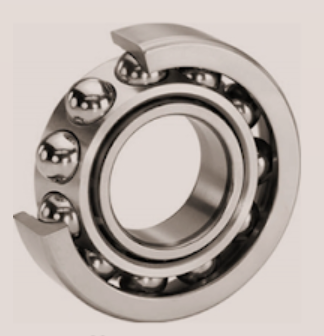- Home/
- GATE MECHANICAL/
- GATE ME/
- Article
Rolling Contact Bearing
By BYJU'S Exam Prep
Updated on: September 25th, 2023

Rolling contact bearings are also known as antifriction bearings because of their reduced friction. Before discussing rolling contact bearing, let’s explain what a bearing is. A bearing is a mechanical component that decreases friction between moving parts by restricting relative motion to only the desired motion. The bearing’s design may allow for free linear movement of the moving part or free rotation around a fixed axis. It may also inhibit motion by controlling the vectors of normal forces acting on the moving parts. By reducing friction, most bearings make it easier to achieve the desired motion.
The contact between the bearing surfaces in rolling contact bearing is rolling rather than sliding, as in sliding contact bearings. Standard sliding bearings have a high coefficient of friction and start at rest with almost metal-to-metal contact. The decreased starting friction of a rolling contact bearing over a sliding bearing is a significant advantage. Let’s take a closer look at rolling contact bearing and its various types.
Download Formulas for GATE Mechanical Engineering – Machine Design
Table of content
What is Rolling Contact Bearing?
A rolling contact bearing carries a load by sandwiching rolling elements (such as balls or rollers) between two concentric, grooved rings known as races. The rolling elements roll with extremely little rolling resistance and minimal sliding due to the relative motion of the races. Sets of logs arranged on the ground with a large stone block on top are one of the earliest and best-known rolling-element bearings.
As the stone is pulled, the logs roll along the ground with little sliding friction. As each log emerges from the back, it is transported to the front, where the block meets it. A typical example of a Rolling contact bearing is laying numerous pens or pencils on a table and placing an item on top that might be used to approximate such a bearing. A shaft is inserted into a much bigger hole in a rolling element rotary bearing, and cylinders known as
ollers snugly fill the space between the shaft and the hole.
Rolling Contact Bearing Diagram

Types of Rolling Contact Bearing
Cages are found in the majority of rolling contact bearings or rolling-element bearings. The cages reduce friction, wear, and bind by preventing the elements from rubbing against each other. Following are the five different types of rolling bearing elements:
- Balls
- Cylindrical rollers
- Spherical rollers
- Tapered rollers
- Needle rollers.
Download Formulas for GATE Mechanical Engineering – I C Engine
Ball Bearing
The ball bearing is a prevalent type of rolling contact bearing or rolling-element bearing. The inner and outer races of the bearing are where the balls roll. Each race has a groove that is normally designed such that the ball fits loosely. In theory, the ball makes touch with each race across a relatively small region. On the other hand, a load on an endlessly small spot would result in infinitely high contact pressure.
In practice, the ball deforms (flattens) little where it comes into contact with each race, similar to how a tyre flattens where it comes into contact with the road. Where each ball presses against it, the race likewise yields slightly. As a result, in this type of rolling contact bearing, the contact between the ball and the race is finite in size and pressure.
Cylindrical Roller Bearing
In this type of rolling contact bearing, the cylinders are used as the shells. The cylinders of standard roller bearings are somewhat longer than the diameter. Roller bearings have a higher radial load capacity than ball bearings but a lower axial load capacity and higher friction. A considerable amount of the load is often carried by fewer than half of the total number of rollers.
Compared to a ball bearing or a spherical roller bearing, the bearing capacity often lowers quickly if the inner and outer races are misaligned. The outer load is constantly re-distributed among the rollers in radial bearings, as it is in all radial bearings.
Download Formulas for GATE Mechanical Engineering – Industrial Engineering
Spherical Roller Bearing
The outer ring of a spherical roller bearing has a spherical internal form. The rollers have a thicker centre section and a thinner end section. As a result, both static and dynamic misalignment can be accommodated by spherical roller bearings.
However, because there will be some sliding between rolling parts and rings, spherical rollers are difficult to produce and thus expensive. The bearings have higher friction than an ideal cylindrical or tapered roller bearing.
Tapered Roller Bearing
Conical rollers roll on conical races in tapered roller bearings. Most rolling contact bearings can only take radial or axial loads. However, tapered roller bearings can take both and generally withstand higher loads than ball bearings due to their larger contact area. For example, most wheeled land vehicles’ wheel bearings are tapered roller bearings.
The disadvantages of tapered roller bearings are that, due to manufacturing complexities, tapered roller bearings are usually more expensive than ball bearings; additionally, the tapered roller acts as a wedge under heavy loads, and bearing loads tend to try to eject the roller; and, in comparison to ball bearings, the force from the collar that keeps the roller in the bearing adds to bearing friction.
Needle Roller Bearing
Needle roller bearings have cylinders that are incredibly long and thin. The ends of the rollers frequently taper to points, which are employed to keep the rollers captive; alternatively, the rollers may be hemispherical and not captive but held by the shaft or a similar arrangement.
In this type of rolling contact bearing, the outside diameter of the bearing is only slightly larger than the hole in the middle due to the thin rollers. On the other hand, the small-diameter rollers must bend dramatically where they contact the races, causing the bearing to fatigue fast.


